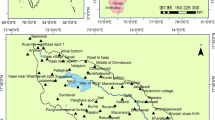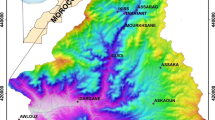Abstract
The current study implements an empirical soil erosion model (RUSLE) along with remote sensing data, and TerrSet algorithms to analyze sediment retention in Wadi Baysh. The ALOS PALSAR digital elevation model was used to delineate watersheds. Rainfall erosivity (R factor) in the study area was calculated using the CHIRPS dataset from 2011 to 2020. K factor of soil erodibility and land use land cover categorization are derived using FAO soil data and a Sentinel-2 image, respectively. Generally, the R factor value is estimated between 91.35 to 115.95 MJ mm/ha/h/year, and the K factor from 0.139 to 0.151 t hah/ha M in the Wadi Baysh. The support vector machines approach divides the area into four major classes. Eighty-one percent of the overall area is barren, 11% is built up, 8% is vegetation, and 1% is water bodies. Using the TerrSet algorithms, the study area approximately losses 57.91 million tons of soil each year. The data show that soil loss is greater in the northeast and south, whereas it is typical in the middle of Wadi Baysh. In conclusion, with this level of sediment load due to the conceptual rainfall erosivity factor, the dam lake of Wadi Baysh, which is located on the downstream side, will be filled shortly in the upcoming 5 years; hence, the appropriate mitigating procedures must be performed.







Similar content being viewed by others
References
Abu-Abdullah MM, Youssef AM, Maerz NH, Abu-Alfadail E, Al-Harbi HM, Al-Saadi NS (2020) A flood risk management program of wadi baysh dam on the downstream area: an integration of hydrologic and hydraulic models, jizan region. Ksa Sustainability 12:1069
Alharthi A, El-Sheikh MA, Elhag M, Alatar AA, Abbadi GA, Abdel-Salam EM, Arif IA, Baeshen AA, Eid EM (2020) Remote sensing of 10 years changes in the vegetation cover of the northwestern coastal land of red sea, Saudi Arabia. Saudi J Biol Sci 27:3169–3179
Ashiagbor G, Forkuo EK, Laari P, Aabeyir R (2013) Modeling soil erosion using rusle and gis tools. Int J Remote Sens Geosci 2:1–17
Atoma H, Suryabhagavan K, Balakrishnan M (2020) Soil erosion assessment using rusle model and gis in huluka watershed, central ethiopia. Sustainable Water Resources Management 6:1–17
Bahrawi J, Alqarawy A, Chabaani A, Elfeki A, Elhag M (2021) Spatiotemporal analysis of the annual rainfall in the kingdom of saudi arabia: predictions to 2030 with different confidence levels. Theoretical and Applied Climatology 146:1479–1499
Bahrawi JA, Elhag M, Aldhebiani AY, Galal HK, Hegazy AK, Alghailani E (2016) Soil erosion estimation using remote sensing techniques in wadi yalamlam basin, saudi arabia. Adv Mater Sci Eng
Balthazar V, Vanacker V, Girma A, Poesen J, Golla S (2013) Human impact on sediment fluxes within the blue nile and atbara river basins. Geomorphology 180:231–241
Barrett B, Nitze I, Green S, Cawkwell F (2014) Assessment of multi-temporal, multi-sensor radar and ancillary spatial data for grasslands monitoring in ireland using machine learning approaches. Remote Sens Environ 152:109–124
Bensekhria A, Bouhata R (2022) Assessment and mapping soil water erosion using rusle approach and gis tools: case of oued el-hai watershed, aurès west, northeastern of algeria. ISPRS Int J Geo Inf 11:84
Boardman J (2006) Soil erosion science: reflections on the limitations of current approaches. CATENA 68:73–86
Churches CE, Wampler PJ, Sun W, Smith AJ (2014) Evaluation of forest cover estimates for haiti using supervised classification of landsat data. Inte J Appl Earth Obs Geoinform 30:203–216
Clague DA, Braga JC, Bassi D, Fullagar PD, Renema W, Webster JM (2010) The maximum age of hawaiian terrestrial lineages: geological constraints from kōko seamount. J Biogeogr 37:1022–1033
Clarkslabs. (n.d) Clarks Labs [Online]. Available: https://clarklabs.org/about/ [Accessed 27 March 2022]
De Jong S, Paracchini M, Bertolo F, Folving S, Megier J, De Roo A (1999) Regional assessment of soil erosion using the distributed model semmed and remotely sensed data. Catena 37:291–308
Diyabalanage S, Samarakoon K, Adikari S, Hewawasam T (2017) Impact of soil and water conservation measures on soil erosion rate and sediment yields in a tropical watershed in the central highlands of Sri Lanka. Appl Geogr 79:103–114
Ejaz N, Elhag M, Bahrawi J, Zhang L, Gabriel HF, Rahman KU (2023) Soil erosion modelling and accumulation using rusle and remote sensing techniques: case study wadi baysh. Kingdom Saudi Arabia Sustain 15:3218
El Jazouli A, Barakat A, Ghafiri A, El Moutaki S, Ettaqy A, Khellouk R (2017) Soil erosion modeled with usle, gis, and remote sensing: a case study of ikkour watershed in Middle Atlas (Morocco). Geoscience Letters 4:1–12
Elhag M, Gitas I, Othman A, Bahrawi J, Gikas P (2019a) Assessment of water quality parameters using temporal remote sensing spectral reflectance in arid environments. Saudi Arabia Water 11:556
Elhag M, Kojchevska T, Boteva S (2019b). Epm for soil loss estimation in different geomorphologic conditions and data conversion by using gis. Iop conference series: Earth And Environmental Science, 2019b. Iop Publishing, 012079
Elhag M, Ioannis G, Anas O, Jarbou B (2020) Effect Of Water Surface Area On The Remotely Sensed Water Quality Parameters Of Baysh Dam Lake, Saudi Arabia. Desalination and Water Treatment 194:369–378
Elhag M, Hidayatulloh A, Bahrawi J, Chaabani A, Budiman J (2022) Using inconsistencies of wadi morphometric parameters to understand patterns of soil erosion. Arab J Geosci 15:1299
Fao I (2015) Global Soil Status, Processes And Trends. Status Of The World’s Soil Resources (Swsr)–Main Report. Rome, Italy: Food And Agriculture Organization Of The United Nations And Intergovernmental Technical Panel On Soils
Farran MM, Elfeki A, Elhag M, Chaabani A (2021) A comparative study of the estimation methods for nrcs curve number of natural arid basins and the impact on flash flood predications. Arab J Geosci 14:1–23
Funk C, Peterson P, Landsfeld M, Pedreros D, Verdin J, Shukla S, Husak G, Rowland J, Harrison L, Hoell A (2015) The climate hazards infrared precipitation with stations—a new environmental record for monitoring extremes. Scientific Data 2:1–21
Garzanti E, Andò S, Vezzoli G, Megid AAA, El Kammar A (2006) Petrology of nile river sands (ethiopia and sudan): sediment budgets and erosion patterns. Earth Planet Sci Lett 252:327–341
Haregeweyn N, Poesen J, Tsunekawa A, Tsubo M, Vanmaercke M, Zenebe A, Nyssen J, Meshesha D, Adgo E (2015) Sediment yield variability at various catchment scales and its impact on reservoirs in the ethiopian highlands. Landscapes and Landforms of Ethiopia 227–238
Hidayatulloh A, Chaabani A, Zhang L, Elhag M (2022) Dem Study On Hydrological Response In Makkah City. Saudi Arabia Sustainability 14:13369
Hussain S, Elfeki AM, Chaabani A, Yibrie EA, Elhag M (2022) Spatio-temporal evaluation of remote sensing rainfall data of trmm satellite over the kingdom of saudi arabia. Theor Appl Climatol 150:363–377
Jakubínský J, Pechanec V, Procházka J, Cudlín P (2019) modelling of soil erosion and accumulation in an agricultural landscape—a comparison of selected approaches applied at the small stream basin level in the czech republic. Water 11:404
Les Sols S (n.d) Exploiter Le Potentiel D’adaptation Du Carbone Organique Des Sols Au Changement Climatique
Maidment DR, Morehouse S (2002) Arc Hydro: Gis For Water Resources, Esri, Inc
Meliho M, Khattabi A, Mhammdi N (2020) Spatial assessment of soil erosion risk by integrating remote sensing and gis techniques: A case of tensift watershed in morocco. Environ Earth Sci 79:1–19
Mitasova H, Hofierka J, Zlocha M, Iverson LR (1996) Modelling topographic potential for erosion and deposition using gis. Int J Geogr Inf Syst 10:629–641
Montgomery DR (2007) Soil erosion and agricultural sustainability. Proc Natl Acad Sci 104:13268–13272
Nampak H, Pradhan B, MojaddadiRizeei H, Park HJ (2018) Assessment of land cover and land use change impact on soil loss in a tropical catchment by using multitemporal spot-5 satellite images and revised universal soil loss equation model. Land Degrad Dev 29:3440–3455
Neitsch S (2000) Erosion soil and water assessment tool theoretical. Documentation Texas Agricultural Eksperiment Station 625
Neitsch SL, Arnold JG, Kiniry JR, Williams JR (2011) Soil and water assessment tool theoretical documentation version 2009. Texas Water Resources Institute
Senanayake S, Pradhan B (2022) Predicting soil erosion susceptibility associated with climate change scenarios in the central highlands of Sri Lanka. J Environ Manage 308:114589
Senanayake S, Pradhan B, Alamri A, Park H-J (2022a) A new application of deep neural network (lstm) and rusle models in soil erosion prediction. Sci Total Environ 845:157220
Senanayake S, Pradhan B, Huete A, Brennan J (2022b) Spatial modeling of soil erosion hazards and crop diversity change with rainfall variation in the central Highlands Of Sri Lanka. Sci Total Environ 806:150405
Singh M, Khera K (2008) Soil erodibility indices under different land uses in lower shiwaliks. Trop Ecol 49:113
Singh G, Panda RK (2017) Grid-cell based assessment of soil erosion potential for identification of critical erosion prone areas using usle, gis and remote sensing: a case study in the Kapgari Watershed, India. Int Soil Water Conserv Res 5:202–211
Sousa KD, Sparks AH, Ashmall W, Etten JV, Solberg SØ (2020) Chirps: api client for the chirps precipitation data In R. J Open Source Software
Tamene L, Park S, Dikau R, Vlek P (2006) analysis of factors determining sediment yield variability in the highlands of northern ethiopia. Geomorphology 76:76–91
Topaloğlu RH, Sertel E, Musaoğlu N (2016) Assessment of classification accuracies of sentinel-2 and landsat-8 data for land cover/use mapping. Int Arch Photogramm Remote Sens Spat Inf Sci 41
Vaezi AR, Abbasi M, Keesstra S, Cerdà A (2017) Assessment of soil particle erodibility and sediment trapping using check dams in small semi-arid catchments. CATENA 157:227–240
Wawer R, Nowocien E, Podolski B (2005) Real And Calculated K Usle Erobility Factor For Selected Polish Soils. Pol J Environ Stud 14:655–658
Wischmeier WH, Smith DD (1978) Predicting Rainfall Erosion Losses: A Guide To Conservation Planning, Department Of Agriculture, Science And Education Administration
Yeshaneh GT (2015) Assessment of soil fertility variation in different land uses and management practices in maybar watershed, south wollo zone, North Ethiopia. Int J Environ Bioremedi Biodegrad 3:15–22
Funding
This research was funded by The Chinese Academy of Sciences (CAS), President’s International Fellowship Initiative (PIFI), grant number 2021VEA0007.
Author information
Authors and Affiliations
Corresponding author
Ethics declarations
Conflict of interest
The authors declare no competing interests.
Additional information
Responsible Editor: Biswajeet Pradhan
Rights and permissions
Springer Nature or its licensor (e.g. a society or other partner) holds exclusive rights to this article under a publishing agreement with the author(s) or other rightsholder(s); author self-archiving of the accepted manuscript version of this article is solely governed by the terms of such publishing agreement and applicable law.
About this article
Cite this article
Elhag, M., Bahrawi, J., Zhang, L. et al. Assessment and quantification of sediment retention and dam management in arid environments using remote sensing techniques. Arab J Geosci 16, 559 (2023). https://doi.org/10.1007/s12517-023-11661-1
Received:
Accepted:
Published:
DOI: https://doi.org/10.1007/s12517-023-11661-1




